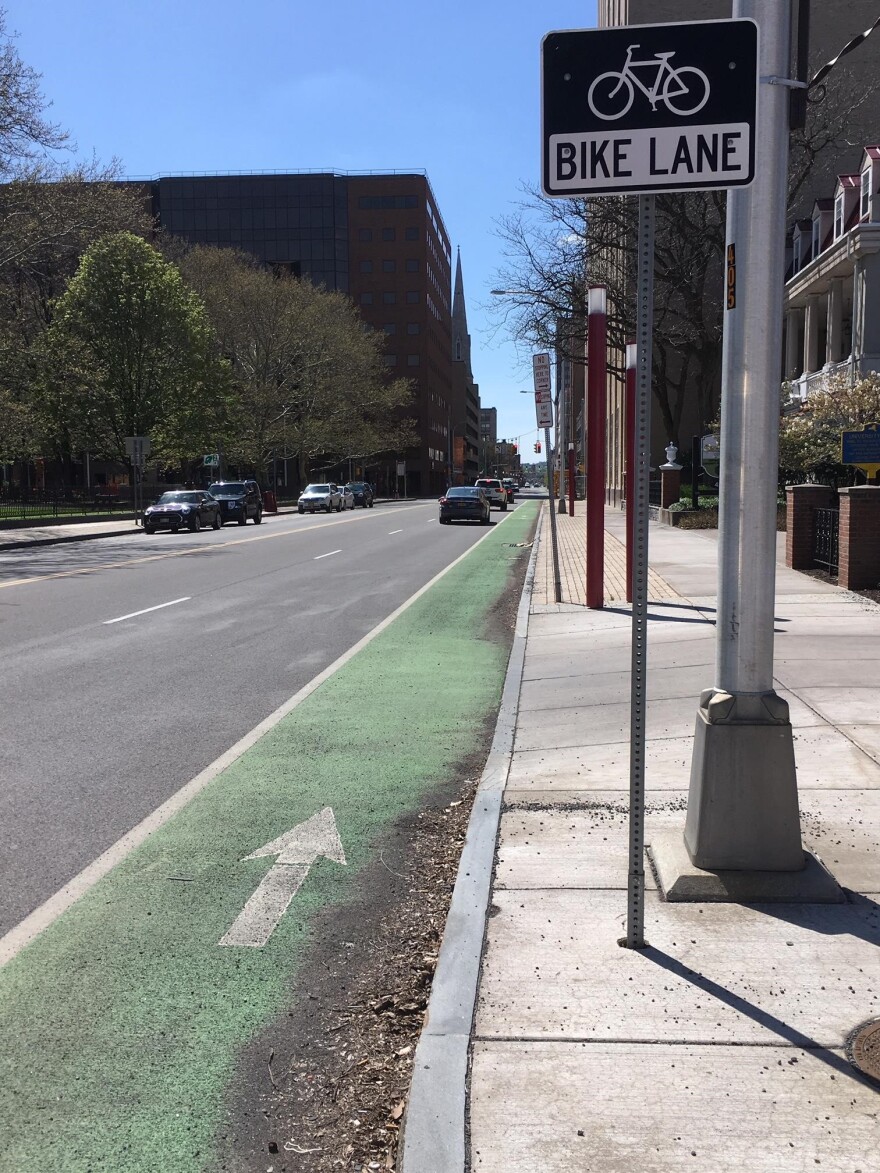When you see bicyclists using a dedicated bike lane, pedestrians strolling along wide sidewalks, buses stopped in a special bus lane, and, of course cars using a roadway, the term “Complete Street” might not come to mind. But that’s just what the City of Syracuse continues to build out since adopting such a framework in 2012.
WAER’S Scott Willis recently met up with DPW Transportation Planner Neil Burke at East Fayette and South Townsend Streets to talk about how all modes of transportation can be accommodated while making streets safer.
“This corner demonstrates pretty well what we’re talking about when we mention complete streets," Burke said.
"Along Fayette Street, you’ll see bright green bike lanes, narrow travel lanes, vehicles moving at slow speeds, well-marked crosswalks, and we have the beeping pedestrian buttons near us. When we say complete, there are a number of items layered together that provide safety for multiple modes. We’re talking bikes, pedestrians, motor vehicles, and transit. A lot of these changes came as a result of the Connective Corridor.”

In contrast, Burke says Townsend Street isn’t as accommodating.
“There are subtle cues that create a much different experience, especially if you’re on foot or on bike. Traffic moves faster. Sidewalks aren’t as wide. There are some maintenance issues. There’s a lack of bike lanes that you see 90 degrees to our left.”
But the city likely won’t be making major improvements to the Townsend street corridor anytime soon. Burke tells me that’s because the roadway is one of many that will see upgrades in the state DOT’s community grid recommendation for I-81. Four lanes could be reduced to two, with a center turn lane and bike lanes, much like Fayette.
I asked Burke if people use the various features of a Complete Street once they’re added, such as bike lanes and crosswalks.
“Generally, yes. We have a very vocal and active contingent of cycling groups in Syracuse. When we do roll out infrastructure upgrades, they tell us they’re happy and using it," he said.
"The Syracuse Metropolitan Transportation Council and the Downtown Committee have compared and contrasted pedestrian numbers...for example, the number of people crossing an intersection over 5 to 10 years. That was recently completed, and we’ve seen a lot higher pedestrian volumes in and around downtown. Obviously there are more apartments and other developments. But we think that’s partly due to the investments we’ve been making with our ADA (Americans With Disabilities Act) corners, and the Connective Corridor.”

It would seem that the most obvious time to install all Complete Streets features would be when the city reconstructs a roadway. But I found out that the city doesn’t want to do this piecemeal.
“If we are doing one block of a street, and it’s on the bicycle master plan, we’re not going to roll-out full-fledged bike lanes jut for one block. What we like to do is take more of a corridor approach connecting destinations instead of one block at a time. It can be slow to materialize, but what it does give us is usable infrastructure instead of just checking a box.”
Burke says it’s about taking a comprehensive approach.
“Some of the things we like to look for in our projects are making sure we’re accommodating all modes. Complete Streets doesn’t mean we’re punishing one mode, or trying to take away from one mode and give to another. It really means we’re trying to accommodate all modes safely and appropriately.”



